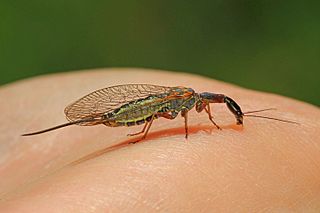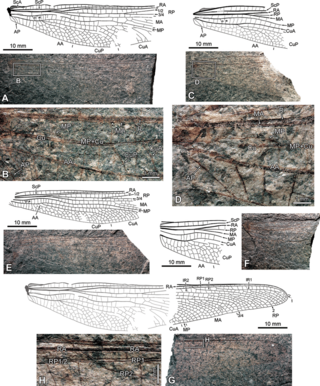
Snakeflies are a group of predatory insects comprising the order Raphidioptera with two extant families: Raphidiidae and Inocelliidae, consisting of roughly 260 species. In the past, the group had a much wider distribution than it does now; snakeflies are found in temperate regions worldwide but are absent from the tropics and the Southern Hemisphere. Recognisable representatives of the group first appeared during the Early Jurassic. They are a relict group, having reached their apex of diversity during the Cretaceous before undergoing substantial decline.
Frank Morton Carpenter was an American entomologist and paleontologist. He received his PhD from Harvard University, and was curator of fossil insects at the Harvard Museum of Comparative Zoology for 60 years. He studied the Permian fossil insects of Elmo, Kansas, and compared the North American fossil insect fauna with Paleozoic taxa known from elsewhere in the world. A careful and methodical worker, he used venation and mouthparts to determine the relationships of fossil taxa, and was author of the Treatise volume on Insects. He reduced the number of extinct insect orders then described from about fifty to nine.
Fibla carpenteri is an extinct species of snakefly in the Inocelliidae genus Fibla. F. carpenteri is named in honor of the paleoentomologist Dr Frank Carpenter, for his vast knowledge and interest in Raphidioptera.
Electrinocellia is an extinct monotypic genus of snakefly in the family Inocelliidae containing the single species Electrinocellia peculiaris and known from Eocene aged Baltic amber.

Florissantoraphidia is an extinct genus of snakefly in the family Raphidiidae containing two described species Florissantoraphidia funerata and Florissantoraphidia mortua. Both species were originally placed in the living raphidiid genus Raphidia, as Raphidia funerata and Raphidia mortua respectively. before being redescribed and transferred to the newly erected genus in 2014.
Ororaphidia is an extinct genus of snakefly containing two species: the type species Ororaphidia megalocephala and Ororaphidia bifurcata.

Styporaphidia is a genus of snakefly, belonging to the extinct family Mesoraphidiidae, containing up to three species, the type species Styporaphidia magia, Styporaphidia willmanni and tentatively Styporaphidia? hispanica. The genus was named from the Greek stypos meaning "stem" or "stump" and Raphidia, the type genus for, and most often used as, a stem for generic names in the order Raphidioptera. The species name of S. magia is from the Greek word mageia meaning "magic" while the species name for S.? hispanica is from the Latin Hispania meaning "Spain" in reference to the type locality of the species.

Archiinocellia is an extinct genus of snakefly in the family Raphidiidae known from Eocene fossils found in western North America. The genus contains two species, the older Archiinocellia oligoneura and the younger Archiinocellia protomaculata. The type species is of Ypresian age and from the Horsefly Shales of British Columbia, while the younger species from the Lutetian Green River Formation in Colorado. Archiinocellia protomaculata was first described as Agulla protomaculata, and later moved to Archiinocellia.
Proraphidia is a genus of snakefly in the extinct family Mesoraphidiidae. The genus currently contains three species; Proraphidia gomezi from the La Pedrera de Rúbies Formation in Spain, Proraphidia hopkinsi from the Weald Clay in England, and the type species Proraphidia turkestanica from Kazakhstan. The genus was first described by O. M. Martynova in 1941 with the publication of P. turkestanica from Jurassic deposits of the Karabastau Formation in Karatau, Kazakhstan.
Kachinus is an extinct genus of ant-like stone beetle in the family Staphylinidae containing the single species Kachinus antennatus.

Agulla is a genus of modern snakeflies in the family Raphidiidae.
Agulla mineralensis is an extinct species of snakefly in the raphidiid genus Agulla. The species is solely known from the Middle Miocene, late Bartovian stage, Pacific Union Site in the Stewart Valley Group, Mineral County, Nevada.
Prophalonia is an extinct genus of moths in the family Incurvariidae. It was described by Rebel in 1936, and contained the species P. acutitarsella and P. gigas. P. acutitarsellus was later transferred to Adelites.
Priscaenigma is an extinct genus of snakefly of the Priscaenigmatidae family which was described by Whalley in 1985. The fossils were found on flatstones at Black Ven in Charmouth, Dorset at 50.7°N 2.9°W in a marine environment of the Charmouth Mudstone Formation. The fossils were collected by J. F. Jackson between 1961 and 1963. Its sister taxa is Hondelagia. The genus contains one species, the extinct Priscaenigma obtusa, also described by Whalley in 1985. Its forewing is 12.6 centimetres (5.0 in) in length. Only a forewing was found when the species was discovered.
Austroraphidia is an extinct genus of snakefly in the family of Baissopteridae. Austroraphidia fossils were described by Willmann in 1994. The genus was later described by Michael S. Engel in 2002. It has five sister taxa; Baissoptera, Cretinocellia, Cretoraphidia, Cretoraphidiopsis and Lugala. Its fossils were found at the Crato MNHN collection in Brazil, often known as the Cretaceous of Brazil. It contains one species, the extinct Austroraphidia brasiliensis, which was described by Nel et al. in 1990. Its average body length is 12.3 centimetres (4.8 in), the forewing is 10.2 by 3.0 centimetres and the hindwing is 9.5 by 2.88 centimetres.
Baissoptera is an extinct genus of snakefly in the Baissopteridae family which was described by Martynova in 1961. Since 1961, it has been described three times; Carpenter in 1992, Ponomarenko in 1988 and Engel in 2002. According to J. Jepson et al. in 2011, the parent taxon is Baissopteridae. Fossils of the species have been found in Brazil, China, Spain and Russia.

Mesoraphidiidae is an extinct family of snakeflies in the suborder Raphidiomorpha. The family lived from the Late Jurassic through the Late Cretaceous and is known from twenty-five genera. Mesoraphidiids have been found as both compression fossils and as inclusions in amber. The family was first proposed in 1925 by the Russian paleoentomologist Andrey Vasilyevich Martynov based on Upper Jurassic fossils recovered in Kazakhstan. The family was expanded in 2002 by the synonymizing of several other proposed snakefly families. The family was divided into three subfamilies and one tribe in a 2011 paper, further clarifying the relationships of the included genera.
Iberoraphidia is an extinct genus of snakefly in the family Mesoraphidiidae. The genus is solely known from a Cretaceous, Lower Barremian, fossil found in Spain. Currently the genus is composed of a single species, Iberoraphidia dividua.

Hondelage is a Stadtbezirk (borough) on the river Schunter in the north-eastern part of Braunschweig, Germany.

Oligotypus is an extinct genus of griffinfly in the family Paralogidae. This genus is known from 4 species from the Carboniferous to Permian.







